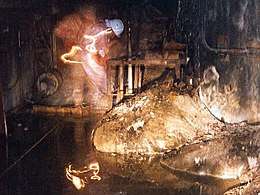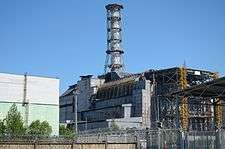The Elephant's Foot

The Elephant’s Foot is an extremely radioactive mass of corium formed during the Chernobyl disaster in April 1986, and was discovered in December 1986. It is named for its wrinkly appearance, resembling the foot of an elephant. The corium mass is beneath Reactor N. 4 of the Chernobyl Nuclear Power Plant, in under-reactor room 217.[1]
The Elephant's Foot is a large mass of black LFCM with many layers, externally resembling tree bark and glass. The mass is quite dense, unyielding to a drill but able to be damaged by a Kalashnikov rifle. By June 1998, the outer layers of the mass began to turn to dust and the entire mass was starting to crack. The mass has penetrated through at least 2 m (6 ft 7 in) of concrete.[1]
The radiation level near the mass was approximately 8,000 roentgens per hour, an invariably lethal dosage of radiation.[2]
Composition
It is composed chiefly of silicon dioxide, with traces of uranium.[3][4] The mass is largely homogeneous, though the depolymerized silicate glass contains occasional crystalline grains of zircon. These grains of zircon are not elongated, suggesting a moderate crystallization rate. While uranium dioxide dendrites grew quickly at high temperatures within the lava, the zircon began crystallization during slow cooling of the lava. Despite the distribution of uranium bearing particles not being uniform, the radioactivity of the mass is evenly distributed.[5]
References
- 1 2 R. F. Mould (2000). Chernobyl Record: The Definitive History of the Chernobyl Catastrophe. CRC Press. p. 130. ISBN 9781420034622.
- ↑ United States Foreign Broadcast Information Service, ed. (1989). "Daily Report: Soviet Union". No. 235–239. The Service.
- ↑ Jaromir Kolejka, ed. (2002). Role of GIS in Lifting the Cloud Off Chernobyl. NATO Science: Earth and environmental sciences. 10 (illustrated ed.). Springer Science & Business Media. p. 72. ISBN 9781402007682.
- ↑ Ann Larabee (2000). Decade of Disaster (illustrated ed.). University of Illinois Press. p. 50. ISBN 9780252068201.
- ↑ Vlasova, Irina; Shiryaev, Andrey; Ogorodnikov, Boris; Burakov, Boris; Dolgopolova, Ekaterina; Senin, Roman; Averin, Alexey; Zubavichus, Yan; Kalmykov, Stepan (2015). "Radioactivity distribution in fuel-containing materials (Chernobyl "lava") and aerosols from the Chernobyl "Shelter"". Radiation Measurements. Elsevier. 83: 20–25.
